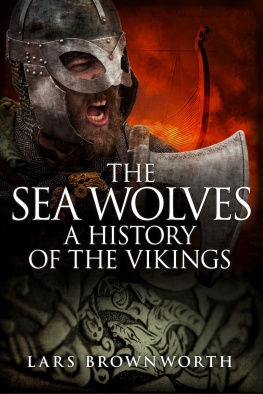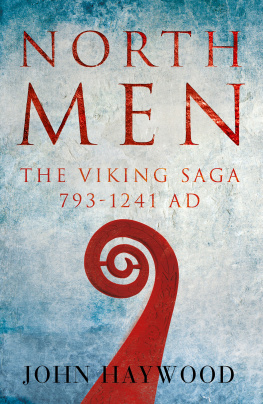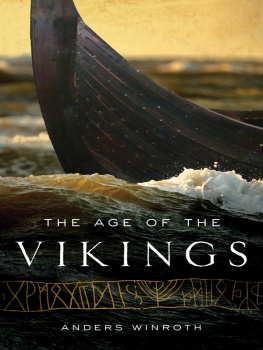THE
VIKING
WARRIOR
THE NORSE RAIDERS
WHO TERRORISED
MEDIEVAL EUROPE
BEN HUBBARD

This digital edition first published in 2016
Published by
Amber Books Ltd
7477 White Lion Street
London N1 9PF
United Kingdom
Website: www.amberbooks.co.uk
Appstore: itunes.com/apps/amberbooksltd
Facebook: www.facebook.com/amberbooks
Twitter: @amberbooks
Copyright 2016 Amber Books Ltd
ISBN: 978-1-78274-305-7
All rights reserved. With the exception of quoting brief passages for the purpose of review no part of this publication may be reproduced without prior written permission from the publisher.
The information in this book is true and complete to the best of our knowledge.
All recommendations are made without any guarantee on the part of the author or publisher, who also disclaim any liability incurred in connection with the use of this data or specific details.

www.amberbooks.co.uk
CONTENTS
Introduction
I n 793 CE fierce omens were recorded in the skies over Northumbria: huge whirlwinds, lightning storms and reports of fiery dragons flying through the air. Then, on 8 June, a wave of Viking warriors broke with a terrible fury onto British shores. In a blizzard of sword blades and battle-axes, they attacked the Northumberland monastery of Lindisfarne and butchered the monks who lived there. Those not killed were carried away in chains; others drowned in the sea. With their ships laden with silver and ecclesiastical treasure, the warriors then set sail for home. The Viking Age had begun.
This is the popular perception of the Vikings, itself an evocative word that conjures up images of bearded warriors, shield-lined longships and piracy, pillage and slaughter. It is a description fed to readers in the West by medieval monks who sat scanning the horizon for striped sails and dragon-head prows with their nervous quills at the ready. For the monks, the Vikings were a thunderbolt from hell: they had appeared without warning and then spread terror and ruin through Europe for almost 300 years.
Using their formidable longships the Vikings repeatedly raided the coastlines of Britain, France and Ireland; they sailed up river arteries to attack cities such as Paris and London; they murdered, kidnapped and enslaved many thousands of people; and they plundered enough wealth to bring whole kingdoms to their knees.
Explorers in Search of Glory
But this is not the whole story of the Vikings, for behind the violence and destruction was a rich and complex culture created over many centuries in their homelands of Scandinavia. It was this culture that united the modern-day countries of Denmark, Norway and Sweden, and bound them by its customs, art, laws, language, stories and beliefs. Watching over the Vikings were their gods: the mighty Thor and the mysterious Odin, the king of the gods whose ravens scoured the earth for news and fed on the corpses of the battlefield dead. It was these pagan deities that inspired the Vikings with their warrior spirit and sense of adventure. From childhood, Vikings were told to fill their lives with glory and honour, to seek wealth and fortune and to win long-lasting fame.
This Isle of Man runestone depicts Odin being devoured by the wolf Fenrir during Ragnark, the last great battle of the gods.
The greatest Vikings were immortalized in epic poems recited from one generation to the next; it was with these heroic tales ringing in their ears that young warriors went a Viking abroad. But it was not all murder and mayhem: the Vikings also used their expert maritime skills to trade and establish new settlements in faraway lands. To enable this exploration and expansion, the Vikings developed the leading seagoing vessel of the medieval age: the longship. Powered by both oars and sails, Viking longships were swift, sleek and built with a shallow draught that allowed them to land quickly on shelving beaches and travel up rivers to ambush settlements inland.
Viking descendants from the Shetland Islands celebrate the Up Helly Aa festival, which culminates in the burning of a replica longship.
The Vikings travelled extraordinary distances, reaching remote lands such as North America, unseen and previously undreamed-of by any European. But they did not only explore the waters of the North Atlantic the Vikings also sailed east down the great rivers of Russia, to Turkey and the Caspian Sea. Many Vikings became regular traders in Constantinople, while at other times they simply attacked the mighty Byzantine capital. Some Vikings joined the ranks of the Byzantine emperors bodyguard, the fabled Varangian Guard.
It is the Vikings in the east that we read about in astonished accounts by travelling Arabs. They tell us that the warriors would have sex with their female slaves in full public view, and sacrifice slave girls during boat burials for their noble dead. To the Arabs, the Vikings were unhygienic boors who carried out their morning ablutions in one shared washbowl. Alongside these warriors, described as tall as palm trees and florid and ruddy of complexion, were their wives, who wore silver necklaces to show off their husbands wealth. Unlike their hapless female slaves, Viking women were protected by the law and on a somewhat equal footing to men. It was illegal to force sex on a Viking woman, and any man who beat his wife would be hunted down like a dangerous animal.
Warrior Raiders
Violence, however, was only ever a moment away in the simple farming and fishing communities of Viking Scandinavia, and no-one was safe from the berserkers. These were the semi-mythological warriors who would enter a frenzied state, foam at the mouth and attack anything that moved friend, family or foe. Berserkers were the crack troops at the front line of any army abroad, but at home they were a blight on society; psychopaths who would rape and kill at will. As such, berserkers often wound up fighting other warriors in duels, a practice used to resolve disputes and restore honour.
An artistic rendering of Eirik the Red (left), the legendary colonizer of Greenland, who is shown here fighting a duel in Iceland.
Honour was of paramount importance to Viking warriors and offence was easily taken. Calling a warrior a woman or accusing him of being sodomized were terrible insults likely to result in duels. These were either impromptu affairs fought to the death, or organized events conducted over an animal hide on an isolated island where nobody could escape. A duel, however, did not always heal an injury to a warriors honour: the enmity could spill over into a generational blood feud that lasted until an entire Viking family had been wiped out.
A memorial stone to Eirik the Reds 982 CE landing in Greenland. The name was enough to convince many Icelanders to help Eirik colonize the new land.



















